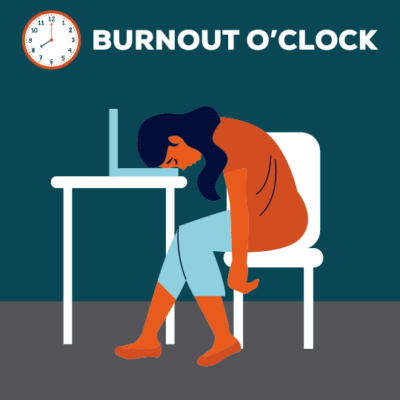Coping Strategies for Burnout
 Oh no. It’s that time – again! Burnout O’clock. If you’re feeling overwhelmed all the time, you might be burned out. If you are procrastinating because you don’t know where to begin, you might be stuck in burnout. If your stress is so high that you’re having physical symptoms like headaches or fatigue, it’s possible that it is burnout.
Oh no. It’s that time – again! Burnout O’clock. If you’re feeling overwhelmed all the time, you might be burned out. If you are procrastinating because you don’t know where to begin, you might be stuck in burnout. If your stress is so high that you’re having physical symptoms like headaches or fatigue, it’s possible that it is burnout.
Coping Strategies for Burnout
Here are three coping strategies for burnout that might be different from things you’ve already done or read about. These will all use your strengths to figure out where the burnout is coming from. And of course, you’ll get ideas for how to tweak the things you’re doing so you can get a new result.
Coping Strategy for Burnout #1 – Identify a Key Time Waster
Maybe you’ve heard of a Stop-Doing List. This step is in that spirit, yet broaden the view beyond today’s task list. Ask yourself, “where do big chunks of time disappear from my week?” “What’s something I spend time on that isn’t enriching to my life?” “What do I do, only because I am people-pleasing?” For example, here are things our clients have listed:
- Binge watching shows or videos at night
- Mindless scrolling over morning coffee
- Attending meetings where you are no longer needed
- Looking up [Rasberry Tea ingredients for an accidental 45 minutes, trying to find a tea without licorice root] – insert any detailed-thing that you didn’t mean to spend that much time on.
- Indulging tangents in a conversation when you’re incredibly behind on a deadline and can’t participate in meandering conversations that day
- Over-tweaking or over-perfecting a deliverable before you hand it off
- Social media scrolling while drinking wine at night
- Allowing a very chatty co-worker to constantly interrupt you because you feel bad telling them to go away and stop talking
- Procrastination-cleaning of your desk
You get the idea. Find something that eats up 30 minutes of your time that you’d love to re-allocate to something else. That’s all you have to do in Step #1 – get awareness about your burnout and where it’s coming from.
Bonus points for your burnout strategies if you can tie it to your strengths or natural preferences because it might tell you about how strengths can go into overuse mode or hindrance mode. For example, here are a couple of examples through the lens of CliftonStrengths.
- My Positivity talent has kept me from setting boundaries in the past. I have allowed people to waste my time, interrupt, or get me into hour-long meetings because I didn’t want to hurt their feelings and tell them no.
- My Maximizer talent has spent thousands of hours making incremental changes to things to improve deliverables. It feels valiant in the moment, yet the ROI isn’t always there.
Coping Strategies for Burnout #2 – Get Out Of Your Rut
Time to change it up. It’s more fun if you’re willing to get creative here. This step is about busting up burnout by stopping or mitigating the time waster. Ask yourself:
- What can you do to approach this thing differently? What’s a novel thing you haven’t tried yet?
- What would be a fun or enriching alternative to the time waster?
- Do you really want to spend those precious minutes on the time waster? If not, how can you create a pattern-interrupt so that you notice you’re doing it again?
This step is begging you to use your strengths. Here’s what I mean. Let’s break down an example:
You’re working on a huge project that is eating you up with meetings at all hours of the day and night. You have so many back-to-back meetings that you can’t get any tasks done. You identified your time waster in Step 1 as “Maintenance Meetings” – you’ve allowed yourself to have 5 hours of recurring meetings per week that are not contributing to project goals, and have minimal ROI. If you are going to get out of this rut, it will help you to be bold and creative.
Experiment with using your CliftonStrengths to give you new approaches.
List 15 things you could do to get rid of the time-waster. Allow yourself to get “out there” with creative options.
Here’s an example list to get you started with our example:
- Take all of these “Maintenance Meetings” from an outdoor location. The sunshine will help you recharge, and will give the meetings a second purpose for your life. If you’re in-person, all the better – turn them into walking meetings outside. You can get in some movement and sunshine at the same time. Now you got back 1 hour that you were going to spend on a walk later.
- Think of one of your strengths that is bold. Use it to help you say no and decline these meetings. Imagine – 5hrs x 52 weeks per year. That’s 260 hours saved with five clicks of the Decline button. If you’re thoughtful about how you decline these meetings, you’re winning big. Use a talent theme like Command to say it short and sweet. Use a talent theme like Adaptability to honor the priorities of the present moment.
- Make these laugh-meetings. If they’re useful, but you’re resenting them because they’re recurring, commit to bringing a lighthearted and fun spirit. Make them fun so that you look forward to coming to them.
- Pick one of your values and set a boundary by honoring your values. In this case the boundary might be on your time – and honoring your values might be telling your teammates you’re not going to be able to attend any longer. That might be driven from a health value or a pragmatic value. No matter what the value is, if it’s deep, it will be a strong compass.
- Experiment with delegation. Find someone else to take your place in these meetings.
- Use this situation as practice. Practice saying no. Practice pulling something off of your plate to make room for bigger priorities. Think of this as an opportunity to save hundreds of hours in the future. Add in your strengths. For example, use your Focus strength to get single-minded about your goal achievement. Use your Strategic talent to be decisive and stop going in circles about whether this is a good decision.
- Your turn…keep this list going
- ?
- ?
- ?
- ?
- ?
- ?
- ?
- ?
Get creative! Use your strengths to find exciting ways to tackle mundane tasks. Inject some novelty to reignite your motivation. Instigate a growth challenge like learning how to say no. These are all ways to re-frame this time waster so that it can be productive for your life.
Coping Strategies for Burnout #3 – Make it Concrete
We call these “do goals” and they have that name because it’s all about the concrete things you’re going to do. Hang with me now. I know it’s tough to think about doing when you’re already feeling maxed out and overwhelmed. It might seem counter intuitive, yet it’s all about breaking it down into the concrete steps.
Let’s continue the example of 5-too-many Maintenance Meetings. Your big goal is to stop going to 5 wasteful meetings. But that’s not concrete, unless you intend to literally stop showing up without communicating with anyone.
If we were working on a coaching call, I’d ask you questions about what would have to happen in order for those 5 meetings to come off your plate. You might say:
- I need to confirm with my manager that I can stop going, or
- I need to send an email to each meeting organizer, or
- I need to click decline 5x, or
- I need to negotiate a deal so that I only need to join for the first 10 minutes of each meeting, or
- I need to find an alternative person to attend
- I need to work on 5 messages so that I can express care for the programs while simultaneously leaving them
You get the idea. These are the actual tactics of the thing. Sometimes you’ll find it’s simpler than you expected. For example, if you only needed to click Decline on five calendar invitations to save 260 hours per year, you would have a mega-win in the burnout department for a 2-minute Do Goal.
It’s probably not that easy, yet what if you dedicated one hour to the careful communication of your exit? What if that one hour of messaging kept you in great graces with your teammates, and it saved you 260 hours this year? Worth it? Yes. Concrete? Yes. Burnout buster? Yes!
Coping Strategies for Burnout – Why Pause To Do This While You’re Overextended
These coping strategies for burnout are simple. They take some thoughtfulness, and if you’ll give a moment of mindfulness to the problem, you might find yourself in a much more gracious pace. Your CliftonStrengths can help you pick the most comfortable and effective strategies to ditch the burnout.
When this moment is behind you, acknowledge how your CliftonStrengths have played a role in overcoming burnout and give yourself a well-deserved pat on the back. Your CliftonStrengths can be a compass that helps you navigate your way back to more energized you. It takes time, yet the concrete “Do Goals” will help you compound your efforts pretty quickly.
3 out of 4 employees experience burnout. It’s obviously bad for productivity and personal health. Plus, who wants to live out life feeling depleted all the time? Especially when you can do something about it. With that, it’s in your hands to take one step.
Go though the process above. Find one time waster. Brainstorm ways to interrupt the pattern and stop. Make your concrete Do Goals so that you can easily take the next action.
Until next time, wishing you deep breaths and slow exhales!
As an international speaker and facilitator, Lisa Cummings has delivered events to over 15,500 participants in 14 countries. You can see her featured in places like Harvard Business Publishing, Training Magazine, and Forbes. She specializes in virtual StrengthsFinder training for teams. When she’s not out spotting strengths in people, you’ll find her playing drums, rescuing dogs, or watching live music in Austin, TX. Her Top 5 StrengthsFinder Talents are: Strategic | Maximizer | Positivity | Individualization | Woo.

